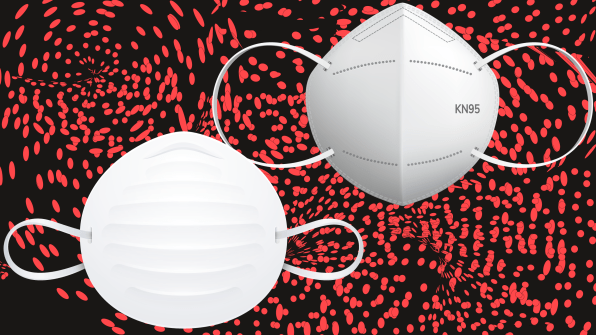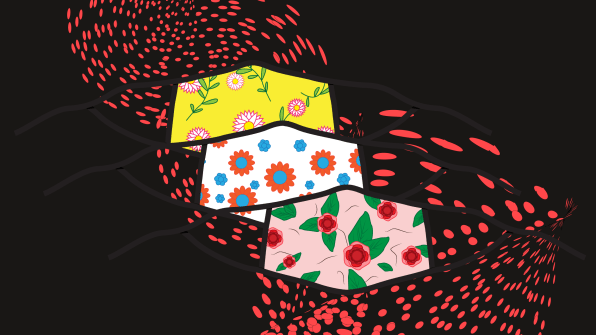After a brief respite over the summer, it may be time to mask up again.
The Delta variant of the coronavirus is now the most prevalent one circulating in the United States, and according to new documents from the Centers for Disease Control and Prevention, it is more transmissible than previously imagined. The data shows that it is just as contagious as chickenpox, and more contagious than the viruses that cause Ebola, the common cold, and the seasonal flu. And while vaccinated people are less likely to get infected with the variant than their unvaccinated counterparts, those who do get infected carry just as much virus in their nose and throat as unvaccinated people, meaning they are just as likely to spread the disease to others.
The CDC has long recommended that the unvaccinated keep wearing masks in indoor settings. But last week, it began advising vaccinated people to wear masks indoors in counties where the virus transmission rates are “substantial” or “high.” (This handy map makes it easy to check whether your neighborhood falls into these categories.) But the CDC stops short of offering guidance on what type of mask to wear to protect yourself. I spoke with two researchers who study masks and COVID-19 transmission to better understand what products will work best in this new phase of the pandemic.

N95s are the gold standard, but they’re not for everyone
For optimal protection, N95 masks, and their Chinese equivalent, KN95 masks, are the gold standard. These are masks that have been certified to filter out 95% of airborne particles as small as 0.3 microns, which means they would prevent coronavirus particles from entering. “These masks are far more efficient as compared to a cloth mask, which will filter out 20% to 50% of particles,” says Christian L’Orange, a professor of mechanical engineering at Colorado State University, whose lab focuses on testing the effectiveness of masks. “That’s assuming they are worn correctly, with a close fit around the face that prevents particles from getting in from the side.”
However, L’Orange points out that many people find it uncomfortable to wear an N95 or KN95 for extended periods of time because it can feel hard to breathe as particles get trapped in the material. He says it’s important to be realistic and find a mask that you can actually wear for as long as you are in an indoor environment. “Sure, an N95 is great if you’re able to do it,” he says. “But if your N95 mask is sitting below your nose, I would much rather [you were] wearing a cloth mask that is well-fitting.”
L’Orange also says that if you are in the market for an N95 or a KN95, be wary of counterfeits. He recommends buying the mask from a reputable retailer like Home Depot or Target rather than from online vendors on eBay or Amazon. Official N95 masks are registered on the website of the National Institute for Occupational Safety, so if you’re concerned about the authenticity of your mask, you can reference this database.

Surgical Masks: Be Wary of Fit
Surgical masks are designed to offer more protection than cloth masks, and they are made from materials that can filter up to 90% of airborne particles. Experts say that the problem with these masks is that they tend to come in a rectangular shape that doesn’t create a close fit, so particles can easily enter through the side. “It doesn’t matter how high quality the mask material is at filtering out airborne particles if it is just loosely drooped on your face,” says Alex Huffman, a professor in the department of chemistry and biochemistry at the University of Denver who studies aerosols, including airborne COVID transmission.
Huffman says it is possible to improve the fit of your surgical mask by making knots on the ear loops and adapting the top of the mask to the bridge of your nose, as demonstrated in video tutorials that have gone viral. But if you see big gaps on the side of your face when you wear a surgical mask, it’s likely that the mask is not doing much to protect you.

Cloth Masks Can Work, If Worn Correctly
Cloth masks can still be an effective tool, according to both L’Orange and Huffman. Given that many Americans already have stacks of cloth masks available from earlier in the pandemic, the experts believe that a large percentage will turn to them during this new wave. If a cloth mask is comfortable enough to be worn for an extended period of time and it fits properly, it can offer some protection against the virus.
Yet there is a lot of variation in terms of how much protection they provide. The key, as with any mask, is to make sure the mask fits tightly on your face. “See that it creates a seal around the cheeks, on the bridge of your nose, and on the chin,” Huffman says. He points out that there are accessories that will allow you to create a better fit, including plastic or rubber strips that go over the mask to keep it well-sealed to the face. There are also some other simple ways to enhance the effectiveness of a cloth mask.
In terms of fabric, L’Orange says that the more tightly woven the material, the better it can protect you. Even if you don’t have information about the particular thread count of the cloth, you can simply examine the material. Both natural materials like cotton and synthetic materials like polyester can work well, as long as there is a tight weave. “If you can see clear daylight through the mask, it’s a pretty good indication the particles are going to get through,” L’Orange says, noting that if you do go for the cloth mask option, it’s important to practice good hygiene. This means washing it frequently and making sure not to leave it on a dirty surface when you’re not wearing it.
The Best Mask is One You Actually Wear
Ultimately, both experts agree that the central tension with masks is that the more efficient they are at filtering out particles, the harder they are to breathe through. So each person needs to make a personal decision about how much discomfort they are willing to tolerate for their own safety. “If a person has a mask that is so uncomfortable to them that they are not actually willing to wear it or [are going to] wear it incorrectly, that’s not the right mask for them,” L’Orange says. “If wearing a slightly less efficient mask means that they wear the mask correctly, that’s probably the better mask for them.”
It’s also worth acknowledging that many Americans are experiencing mask fatigue, Huffman says. The pandemic has dragged on for nearly a year and a half, and many people hoped that by now we would not have to deal with the inconvenience and discomfort of wearing masks. Huffman points out that we’re not exactly where we were a year ago. We no longer need to wear masks outside, unless we’re in crowded areas. And if we’re vaccinated, we can now meet with vaccinated relatives and friends at home unmasked. “The context on where to wear a mask is important,” he notes. “When you are in public areas indoors and you don’t know the people you are in close quarters with, that’s when you need to step up, wear your mask, and protect yourself as much as possible.”
(69)